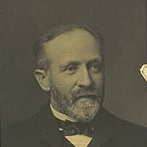Presidential Address
In Memoriam
From the American Historical Review 44:1 (October 1938)
George Lincoln Burr (January 30, 1857–June 27, 1938) George Lincoln Burr, who died at Ithaca on June 27, was born at Oramel, New York, on January 30, 1857. As a boy he learned the trade of printer, by the practice of which he partly supported himself through school and college. Graduating from Cornell in 1881, he spent three years (1884–86 and 1887–88) in Leipzig, Paris, and Zurich. On his return in 1888 he was appointed to a position on the Cornell faculty, holding the chair of medieval history from 1892 to 1922. His teaching included the period of the Renaissance and Reformation, for he considered the sixteenth century more medieval than modern. From 1887 he was also librarian of the President White Library at Cornell, which he made one of the best collections of books in America and in some fields, notably in the history of superstition, the best in the world. In 1896 he was appointed historical expert on the commission appointed by President Cleveland to investigate the boundary between Venezuela and British Guiana. His report, published in r900, was useful in the arbitration that finally settled the dispute. In recognition of his services Burr was given the degree of LLD by the University of Wisconsin in 1904 and the degree of LittD by Western Reserve University in 1905. From 1905 to 1916 he was associate editor of the American Historical Review. In 1916–17 he was president of the American Historical Association. Taking as the subject of his presidential address “The Freedom of History,” he traced the history of freedom in this discipline. His specialty was the history of superstition. The Literature of Witchcraft (1890) is a bibliography with some translations of sources. The Fate of Dietrich Flade (1891) reconstructs from manuscripts the trial and execution for the crime of witchcraft of an eminent citizen of Cologne. In Narratives of the Witchcraft Cases (1913) Burr edited some of the sources for the history of witch-hunting in New England. When Henry Charles Lea died in 1909, his large unfinished manuscript history of witchcraft was turned over to Burr for editing. This exacting task was completed, with the aid of Professor Arthur Charles Howland, just before Burr’s death, the work being now in the hands of the printers. Much of Burr’s learning has gone into the books of others. In the preface to A History of the Warfare of Science and Theology Andrew D. White acknowledges his great debt to “the contributions, suggestions, criticisms, and cautions” of his pupil and dear friend. Professor E. M. Hulme has based his excellent textbooks, The Middle Ages and The Renaissance, the Protestant Revolution, and the Catholic Reformation, on the outlines of Burr’s lectures, with full and graceful expression of obligation. Hundreds of other scholars have been indebted to Burr for suggestion and criticism. There was in his nature an uncommon generosity that led him to give to others more, both of his income and of his great stores of learning, than he kept for his own use.
Bibliography
Narratives of the witchcraft cases, 1648–1706, ed. by George Lincoln Burr with three facsimiles. New York: C. Scribner’s Sons, 1914; Reprint, Mineola, N.Y.: Dover Publications, 2002.
George Lincoln Burr: his life, by Roland H. Bainton; selections from his writings, edited by Lois Oliphant Gibbons. Ithaca, N.Y.: Cornell university press, 1943.
Persecution and liberty; essays in honor of George Lincoln Burr. Freeport, N.Y.: Books for Libraries Press, 1968.
New England’s place in the history of witchcraft. Freeport, N.Y.: Books for Libraries Press, 1971.
